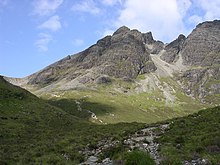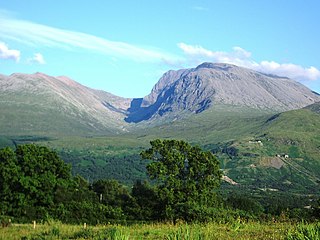
A Munro is defined as a mountain in Scotland with a height over 3,000 feet (914.4 m), and which is on the Scottish Mountaineering Club (SMC) official list of Munros; there is no explicit topographical prominence requirement. The best known Munro is Ben Nevis, the highest mountain in the British Isles at 4,411 ft.

The Cuillin is a range of mostly jagged rocky mountains on the Isle of Skye in Scotland. The main Cuillin ridge is also called the Black Cuillin to distinguish it from the Red Cuillin, which lie to the east of Glen Sligachan.

Knoydart is a peninsula in Lochaber, Highland, on the west coast of Scotland. Knoydart is sandwiched between Lochs Nevis and Hourn — often translated as "Loch Heaven" and "Loch Hell" respectively, although the somewhat poetic nature of these derivations is disputed. Forming the northern part of what is traditionally known as na Garbh-Chrìochan or "the Rough Bounds", because of its harsh terrain and remoteness, Knoydart is also referred to as "Britain's last wilderness". It is only accessible by boat, or by a 16-mile (26 km) walk through rough country, and the seven miles (11 km) of tarred road are not connected to the UK road system.

Blà Bheinn or Blàbheinn, also known as Blaven, is a mountain on the Isle of Skye in Scotland. It is usually regarded as an outlier of the Black Cuillin range. It is a Munro with a height of 929 metres (3,048 ft). North of the summit is the ridge of Clach Glas, which leads to the peaks of Garbh-bheinn and Sgùrr nan Each. It is mainly composed of gabbro, a rock with excellent grip for mountaineers and scramblers.

Professor John Norman Collie FRSE FRS, commonly referred to as J. Norman Collie, was an English scientist, mountaineer and explorer.

Schiehallion is a prominent cone-shaped mountain in the Breadalbane region of the Scottish Highlands, in the county of Perthshire. It rises to 1,083 metres (3,553 ft) and is classed as a Munro. Schiehallion has a rich flora, interesting folklore and archaeology, and a unique place in scientific history for an 18th-century experiment in "weighing the Earth". It is near the centre of mainland Scotland. The mountain's popularity amongst walkers led to erosion on its footpath and extensive repairs were undertaken in 2001.

Assynt is a sparsely populated area in the south-west of Sutherland, lying north of Ullapool on the west coast of Scotland. Assynt is known for its landscape and its remarkable mountains, which have led to the area, along with neighbouring Coigach, being designated as the Assynt-Coigach National Scenic Area, one of 40 such areas in Scotland.
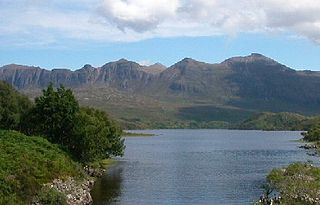
Quinag is an 808 m high mountain range in Sutherland in the Scottish Highlands, with an undulating series of peaks along its Y-shaped crest. The name Quinag is an anglicisation of the Gaelic name Cuinneag, a milk pail, reflecting its distinctive shape.

Scotland is the most mountainous country in the United Kingdom. Scotland's mountain ranges can be divided in a roughly north to south direction into: the Scottish Highlands, the Central Belt and the Southern Uplands, the latter two primarily belonging to the Scottish Lowlands. The highlands eponymously contains the country's main mountain ranges, but hills and mountains are to be found south of these as well. The below lists are not exhaustive; there are countless subranges throughout the country.
The Northwest Highlands are located in the northern third of Scotland that is separated from the Grampian Mountains by the Great Glen. The region comprises Wester Ross, Assynt, Sutherland and part of Caithness. The Caledonian Canal, which extends from Loch Linnhe in the south-west, via Loch Ness to the Moray Firth in the north-east splits this area from the rest of the country. The city of Inverness and the town of Fort William serve as gateways to the region from the south.

John Muir's Birthplace, in Dunbar, East Lothian, Scotland, is a museum run by East Lothian Council Museums Service as a centre for study and interpretation of the work of the Scottish-American conservationist John Muir.

The Isle of Skye, or simply Skye, is the largest and northernmost of the major islands in the Inner Hebrides of Scotland. The island's peninsulas radiate from a mountainous hub dominated by the Cuillin, the rocky slopes of which provide some of the most dramatic mountain scenery in the country. Although Sgitheanach has been suggested to describe a winged shape, no definitive agreement exists as to the name's origins.

Adam Watson, FRSE, FRSB, FINA, FRMS, FCEH was a Scottish biologist, ecologist and mountaineer. He was one of the most recognisable scientific figures in Scotland due to his many appearances on TV and radio. His large academic output and contributions to the understanding of the flora and fauna in Scotland and elsewhere have been internationally recognised. Dr Watson was widely acknowledged as Scotland's pre-eminent authority on the Cairngorms mountain range.

Strathaird is a peninsula on the island of Skye, Scotland, situated between Loch Slapin and Loch Scavaig on the south coast.
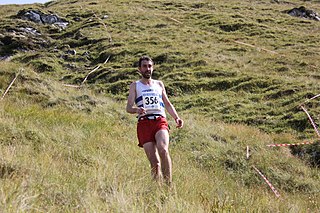
Finlay Wild is a Scottish runner and mountaineer who has been a British fell running champion. He has won the Ben Nevis Race twelve times.
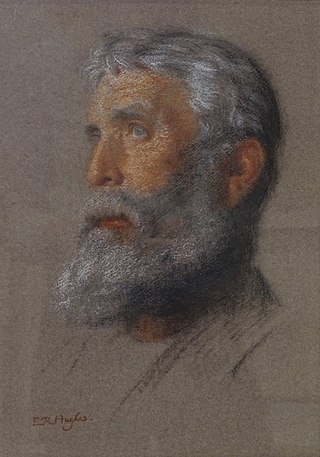
John Morton MacKenzie (1856–1933) was a Gaelic speaking crofter from Sconser on the Island of Skye and Britain’s first professional mountain guide.
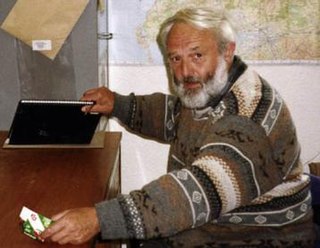
Irvine Butterfield (1936–2009) was an environmentalist, hillwalker and author of several books about mountains and the outdoor environment who took a significant role in the running of organisations with such interests in Scotland. He was a good organiser and volunteered large amounts of his time to causes he believed in.

Sgùrr Dubh Mòr is a 944-metre (3,097 ft) mountain, a Munro, in the Cuillin range on the Isle of Skye in Scotland. It is slightly to the east of the main Cuillin ridge at the highest point of the Dubh ridge which extends eastwards to Loch Coruisk.

Sgùrr nan Eag is a mountain 924 metres (3,031 ft) high in the Cuillin range on the Isle of Skye, Scotland. It is the southernmost Munro of the Cuillins and it lies between Coir' a' Ghrunnda to the west, Gars-bheinn to the east, and Garb-choire to the north.

The Carrifran Wildwood is a project by the Borders Forest Trust (BFT) to re-establish native woodland and the associated ecology within Carrifran, a glen NE of Moffat in the Moffat Hills, part of the Southern Uplands of Scotland.

